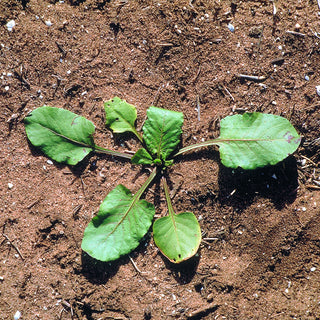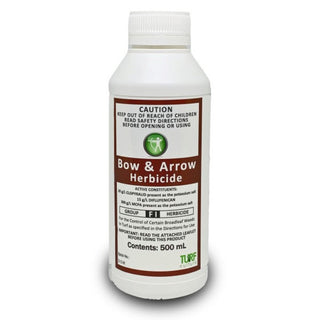Botanical name: Emex australis
Common Names
Doublegee, Spiny Emex, Three-Cornered Jack, Cat-Head, Prickly Jack, Giant Bull Head, Tanner’s Curse, Cape Spinach
DISTINGUISHING FEATURES
Doublegee is a vigorous annual herb with a strong tap root and a long, fleshy, hairless stem. The cotyledons are hairless, elongated and club-shaped. Subsequent leaves are alternate, hairless and triangular with undulating margins. Ovate leaves form a prostrate rosette at early stages of growth but can assume a semi-erect habit in dense crop or pasture. Round, ribbed stems branching from the centre of the rosette may grow up to 600 millimetres (mm) in length. Clusters of very small, inconspicuous white flowers produce hard woody achenes with three sharp spines radiating from the apex.
BIOLOGY
Doublegee can grow on a wide range of soil types from loam to clay loam. In WA it is associated mainly with red brown soils where pH is neutral to slightly alkaline. Doublegee seeds germinate mainly in autumn and winter although germination may occur any time during the year. Doublegee achenes may remain viable in soil for longer than four years. An autumn cultivation will stimulate emergence of the seedlings and if these seedlings are killed the level of viable seeds in the soil will decrease rapidly.
Germination of doublegee seed occurs over a wide range of temperatures (day and night temperatures from 5-10°C and 25-35°C) and more quickly at higher temperatures. The emergence of seedlings usually starts in autumn after sufficient rain, with warm and moist conditions being more congenial for growth and reproduction. Summer rains can enable some doublegee seeds to germinate and these plants can successfully complete development. Seedling emergence is higher in heavier soil types than in sandy soils, with unburied seeds having a low germinability and very few seeds germinate from deeper than 50mm. Doublegee achenes can remain viable in soil for longer than four years.
WHY IS IT A WEED?
A significant weed of agriculture in temperate Australia, doublegee causes a loss of $20 million annually over an estimated one million hectares of crops and one million hectares of pastures in WA alone.
- A presence of 8-9 doublegee plants/m2 can reduce wheat yield by up to 50%.
- One doublegee plant growing under ideal conditions in the absence of competition may spread up to one meter in diameter and produce as many as 1100 seeds.
SIMILAR SPECIES
May be confused with English spinach and Bindii.
SCENARIOS AND SOLUTIONS:
- In garden beds: spot spray Apparent Ravage.
- In couch & kikuyu lawns: use any of the product recommended below.
- In buffalo grass: Apparent Bromoxynil + MCPA.
Reference: https://www.agric.wa.gov.au/grains-research-development/doublegee







